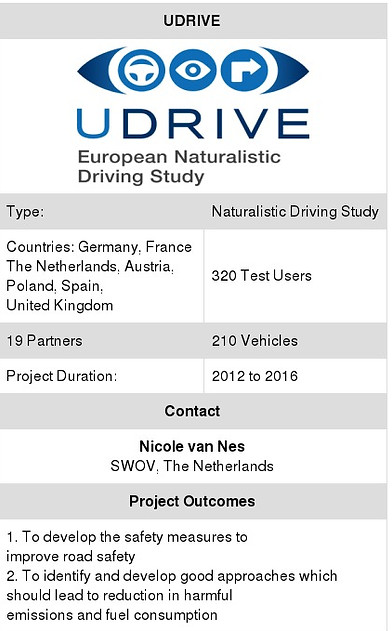Introduction
UDRIVE is large scale European Naturalistic Driving (meaning that the behavior of road users is observed unobtrusively in a natural setting) Study on cars, trucks and powered-two wheelers. The acronym stands for “eUropean naturalistic Driving and Riding for Infrastructure & Vehicle safety and Environment”.
Cars, trucks and powered-two wheelers (motorcycles & scooters) have been equipped with sensors and cameras and, which provides continuous and detailed information about the driver and the vehicle in interaction with other road users. Basically, this project aims to enhance the understanding of road user behavior.
Over a period of two years, UDRIVE has collected naturalistic driving data for cars, lorries and powered two wheelers (PTW). The datalogger developed in the project, continuously registered over 100 variables, such as GPS, CAN bus, extensive footage of the environment of the car and the car’s interior. Research in the UDRIVE project focused on distraction, interaction with cyclists and pedestrians, risky driving and ‘eco-driving’. Based on the results, improvements can be made for road safety and the environment.
Objective

This project aims at yielding the quantitative results of focus points and developing the best approaches in a scientific & technical point of view - as listed below:
-
Quantifying road user behaviors like driver distraction, driver inattention and driver interactions with vulnerable road users (VRUs) like pedestrians and cyclists, in different European Regions in regular traffic conditions and near-miss accident situations.
-
Quantifying the effects of driving style, road & road network characteristics and traffic conditions on emission and fuel consumption levels.
Inputs
-
120 Renault Clio and Megane, 40 Piaggio Liberty & 50 VOLVO trucks have been deployed in to the test to collect 75 TB of data for analysis.
-
Infrastructure: Data acquisition system provided by SECTRONIC based on 8 Video channels
-
MobileEye front facing sensor, GPS, 3D accelerometers and microphone have been equipped into all the vehicles record the data.
-
Since it is naturalistic driving test, some selected areas (termed as operation sites) in 6 countries were identified to carry out the test.
The choice of operation sites was motivated by aiming at having a good spread over countries with different characteristics in terms of road safety records, road user behavior, road infrastructure characteristics, the presence of vulnerable road users, climate, traffic density, etc. Also, the leader of these operation sites was selected based on the experience in ND (Naturalistic Driving) tests with their target group.

Project Process / Methodology
-
Proposed Approach: UDRIVE proposes three-fold approach to drive towards the objective
-
At the first level, defining measurable safety & environment KPIs to monitor the developments over time.
-
Improving the existing driver behavior models accordingly based on the KPIs, which when used in traffic flow simulations, one can estimate / predict the effects of variations of KPIs on safety and environment.
-
Based on the results & estimations, support to the road users will be provided in the form of driver support systems (like ADAS) and targeted training to provide awareness on safer and more fuel-efficient driving.
-
Based on this approach, UDRIVE has formulated 5 steps of the FESTA-V approach:
-
Study Design
-
Data Management
-
Data Collection
-
Data Analysis
-
Impact
-
Each of these five steps will be executed in a sub-project (SP) with strong inter-relationships with each other. On top, there is an additional SP that deals with Management & Dissemination, i.e., the overall project coordination, the scientific quality of the project and the dissemination activities.

